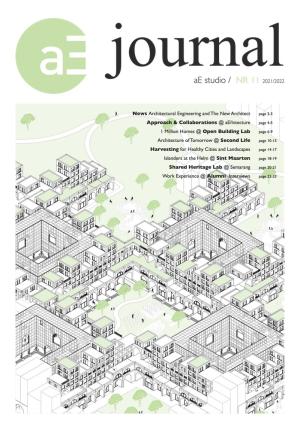Hosted by
aE Journal 2020/2021: Architectural Engineering and The New Architect
Synopsis
Does architecture still belong to the architect?
Building is getting more and more complicated. Today an architect must be able to work across multiple disciplines. A new generation of architects attach less importance to ‘authorship’. Do architects see themselves as independent consultants any longer? They increasingly act as entrepreneurs who are part of a team of various disciplines and fields. Responsibility for a building or work of art is borne by several parties instead of just the architect. Does the team jointly take responsibility for architectural quality? In other words, does architecture still belong to the architect?
Influence of users
Influence of end-users is very important for every building. In the twentieth century we started with huge home productions. Many people had to be housed. Today there is a much greater need for how such mass production can adapt to the people themselves. How can you provide an answer to what is needed? We are working on mass customised building systems to optimise the high demand for housing. In the twentieth century, an architect said, “It’s not what they want, it’s what you want.” This attitude seems completely reversed and requires new answers from the architect. Another factor is that new digital technologies linked to machine-based production methods give great freedom in manufacturability. Think of 3D printing, robotics and CNC milling, for example. More freedom of design is generated. The “new architect” can play an ingenious role in this. In terms of process and product. Connecting digitisation and materialisation integrally.
Architectural sustainability
The aesthetic aspect will never be subordinate. You don’t just demolish a well-designed building. We attach ourselves to it. The aim must be to make sustainability and circularity an integral part of the creation of architecture. The implementation of the assignment can consist of assembling numerous different components, each of which also has its own life cycle. Designers together with clients must take the lead in this. We need new inspiring examples in the field of architecture that show society how we can build sustainably and intelligently. Government and investors must stimulate this.
Create valuable neighbourhoods
We must continue to work on making our own identities and culture visible. And we have to strengthen it. Diversity must remain linked to local and climatic conditions and the availability of materials. It is precisely by making use of the local availability of energy, materials and of the mobility that can be enhanced on site (such as water), that design choices remain inspired and influenced by local circumstances. Especially now that we are increasing parametric design and implementing digital systems in our daily practice, it requires new digital craftsmanship.
The new architect
Well-trained architects across all scales must be the pioneers of smart buildings and urban structures that also have cultural added value. This should be encouraged. It is called ‘value by design’. The complexity of our assignments is huge. Major architectural issues in urban and landscape environments await us, where it is of paramount importance that these can be tackled by the right talents with the right attitude. They must be supported in this by science, education, professionals, industry, politics and clients. This requires an attitude from the architect that I summarise as “the new architect”. This attitude is of added value to our society at all levels of the use of our built and unbuilt environment. This attitude is the guiding theme for aE. The future is now.

